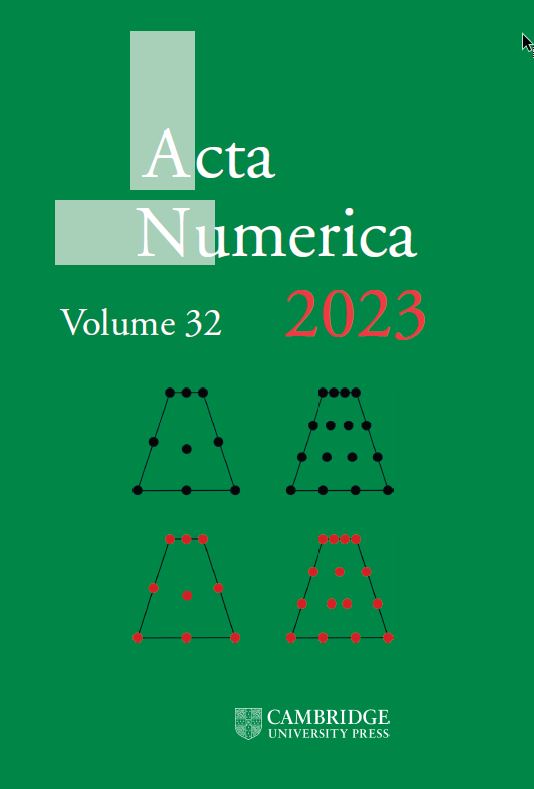数值线性代数的通信下界和最优算法*†
IF 11.3
1区 数学
Q1 MATHEMATICS
引用次数: 118
摘要
数值算法效率的传统度量是它执行的算术运算的数量。长期以来,技术趋势一直在减少执行算术运算的时间,因此它不再是许多算法的瓶颈;相反,通信或移动数据才是瓶颈。这促使我们寻求尽可能少移动数据的算法,无论是在内存层次结构的级别之间还是在网络上的并行处理器之间。本文从三个方面综述了该问题的最新进展。首先,我们描述通信的下限。其中一些将已知的密集经典(O(n3))矩阵乘法的下界推广到线性代数的所有直接方法,顺序和并行算法,以及密集和稀疏矩阵。我们还提出了类似strassen算法的下界,以及迭代方法,特别是应用于稀疏矩阵的Krylov子空间方法。其次,我们将这些下界与这些算法的广泛使用版本进行比较,并注意到这些广泛使用的算法通常比必要的更渐进地通信。第三,我们为大多数线性代数问题识别或发明了新的算法,这些算法确实达到了这些下界,并在理论和实践中证明了很大的加速。本文章由计算机程序翻译,如有差异,请以英文原文为准。
Communication lower bounds and optimal algorithms for numerical linear algebra*†
The traditional metric for the efficiency of a numerical algorithm has been the number of arithmetic operations it performs. Technological trends have long been reducing the time to perform an arithmetic operation, so it is no longer the bottleneck in many algorithms; rather, communication, or moving data, is the bottleneck. This motivates us to seek algorithms that move as little data as possible, either between levels of a memory hierarchy or between parallel processors over a network. In this paper we summarize recent progress in three aspects of this problem. First we describe lower bounds on communication. Some of these generalize known lower bounds for dense classical (O(n3)) matrix multiplication to all direct methods of linear algebra, to sequential and parallel algorithms, and to dense and sparse matrices. We also present lower bounds for Strassen-like algorithms, and for iterative methods, in particular Krylov subspace methods applied to sparse matrices. Second, we compare these lower bounds to widely used versions of these algorithms, and note that these widely used algorithms usually communicate asymptotically more than is necessary. Third, we identify or invent new algorithms for most linear algebra problems that do attain these lower bounds, and demonstrate large speed-ups in theory and practice.
求助全文
通过发布文献求助,成功后即可免费获取论文全文。
去求助
来源期刊

Acta Numerica
MATHEMATICS-
CiteScore
26.00
自引率
0.70%
发文量
7
期刊介绍:
Acta Numerica stands as the preeminent mathematics journal, ranking highest in both Impact Factor and MCQ metrics. This annual journal features a collection of review articles that showcase survey papers authored by prominent researchers in numerical analysis, scientific computing, and computational mathematics. These papers deliver comprehensive overviews of recent advances, offering state-of-the-art techniques and analyses.
Encompassing the entirety of numerical analysis, the articles are crafted in an accessible style, catering to researchers at all levels and serving as valuable teaching aids for advanced instruction. The broad subject areas covered include computational methods in linear algebra, optimization, ordinary and partial differential equations, approximation theory, stochastic analysis, nonlinear dynamical systems, as well as the application of computational techniques in science and engineering. Acta Numerica also delves into the mathematical theory underpinning numerical methods, making it a versatile and authoritative resource in the field of mathematics.
 求助内容:
求助内容: 应助结果提醒方式:
应助结果提醒方式:


